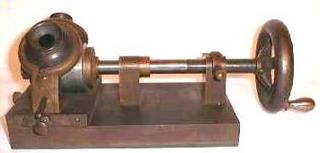 We couldnt have airchecks without recording so I am going to give a little extra back story...
We couldnt have airchecks without recording so I am going to give a little extra back story...In 1857, Edouard-Leon Scott de Martinville received French patent #17,897/31,470 for the phonautograph. This device made a visual image of sound waves on a cylinder, but did not record reproduceable sound.
1876, Charles Cros deposited a paper on audio recording at the Paris Academy of Sciences titled PROCESS OF RECORDING AND OF REPRODUCING AUDIBLE PHENOMENA. It contained the correct and working process for recording and replaying audio. It is not known if he built a prototype. Later prototypes produced things like this:

1877 - Edison made the first recording of a human voice ona tin cylinder. He may have successfully recorded prior to this on an early paper model derived from his telegraph repeater.
1878 - Frank Lambert developed a talking clock. I should say tried to develop a talking clock. Soft tinfoil was the recording medium of the day and did not produce a lasting copy. Lambert used a lead cylinder in his prototype. Because of this, we can play back this early recording attempt today. Pic of device below...

His device is in the Guinness Book of World Records as the world's oldest playable recording. The recording. It seems to have been recorded at about 85 revs per minute. If you are patient you will hear lambert reading out the hours. The Lambert talking Clock is on display at the National Clock and Watch Museum in Columbia, PA. Audio orginates at tinfoil.com. They are absolutely amazing, please visit their site.
Listen: http://tinfoil.com/lam-clock~.mp3
Visit: http://www.nawcc.org/
Ok, Airchecks tomorrow, I promise.




No comments:
Post a Comment